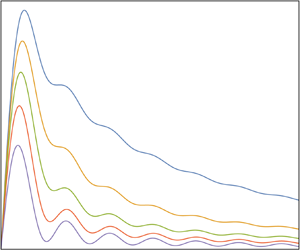Article contents
Added mass of oscillating bodies in stratified fluids
Published online by Cambridge University Press: 20 May 2024
Abstract

The concept of added mass is generalized to stratified fluids, accounting for the presence of internal waves. Once the added mass of a moving body is known, so is the hydrodynamic force exerted on it by the fluid, and the energy imparted by it to the fluid. As a function of frequency, added mass is complex. Its real part is associated with inertia and its imaginary part, only present in the frequency range of propagating waves, with wave damping. Owing to causality, these two parts satisfy Kramers–Kronig relations. The added masses of an elliptic cylinder of horizontal axis, typical of two-dimensional bodies, and a spheroid of vertical axis, typical of three-dimensional bodies, are deduced from their dipole strengths, themselves deduced from their representations as single layers. The wave power is shown to be a maximum, for fixed oscillation amplitude, at approximately  $0.8$ times the buoyancy frequency. In the temporal domain, added mass appears as a new memory force taking the form of a convolution integral. The kernel of this integral combines algebraically decaying oscillations at the buoyancy frequency on the one hand; and an exponentially damped oscillation for the horizontal motion of the spheroid, implying short-term memory, an aperiodic algebraic decay for its vertical motion, implying long-term memory, and a constant for the motion of the cylinder, implying everlasting memory, on the other hand. A limitation of the study is its restriction to translational motion.
$0.8$ times the buoyancy frequency. In the temporal domain, added mass appears as a new memory force taking the form of a convolution integral. The kernel of this integral combines algebraically decaying oscillations at the buoyancy frequency on the one hand; and an exponentially damped oscillation for the horizontal motion of the spheroid, implying short-term memory, an aperiodic algebraic decay for its vertical motion, implying long-term memory, and a constant for the motion of the cylinder, implying everlasting memory, on the other hand. A limitation of the study is its restriction to translational motion.
- Type
- JFM Papers
- Information
- Copyright
- © The Author(s), 2024. Published by Cambridge University Press
References
- 4
- Cited by



